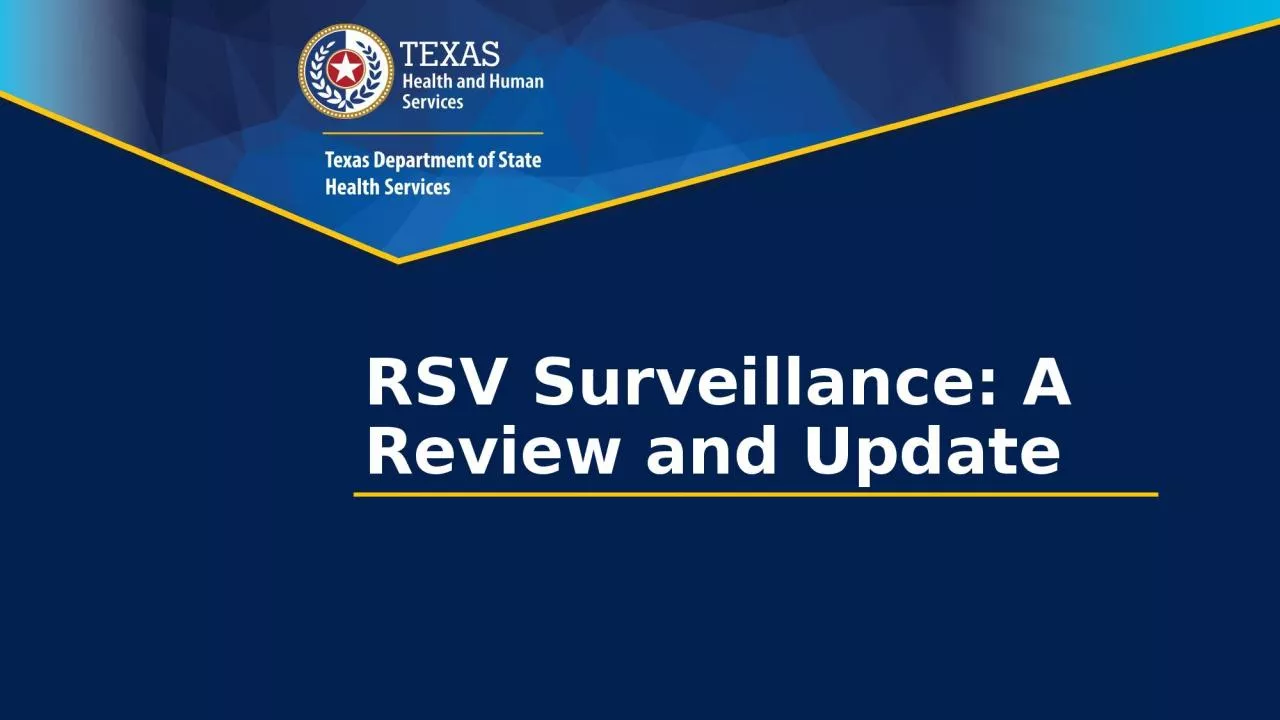

Overview Current RSV Respiratory Syncytial Virus Surveillance Data Availability and Use Considerations of Changing Environment Review Current RSV Surveillance Individual cases of RSV are not ID: 1036530
Download Presentation The PPT/PDF document "RSV Surveillance: A Review and Update" is the property of its rightful owner. Permission is granted to download and print the materials on this web site for personal, non-commercial use only, and to display it on your personal computer provided you do not modify the materials and that you retain all copyright notices contained in the materials. By downloading content from our website, you accept the terms of this agreement.
1. RSV Surveillance: A Review and Update
2. OverviewCurrent RSV (Respiratory Syncytial Virus) SurveillanceData Availability and UseConsiderations of Changing EnvironmentReview
3. Current RSV Surveillance Individual cases of RSV are not a reportable conditionExceptions include:Unusual group of expression of disease and Outbreaks of any kind and any are considered reportable, including RSVPassive Sentinel SurveillanceLab data is voluntarily reported by Texas laboratories participating in the National Respiratory and Enteric Virus Surveillance System (NREVSS)NREVSSCDC ProgramParticipating Laboratories report weeklyCurrently the only source of RSV data
4. Current RSV Surveillance Seasonality ChangesRSV seasons during COVID-19 (2020-2022) saw peaks of activity during summer monthsThis was uncommon and may have been due to COVID-19Most recent season (2022-2023) saw a shift back to regular seasonality with a peak in OctoberDSHS Collaboration with RSV Task ForceRSV Task Force is a subcommittee of TPS (Texas Pediatric Society) composed of healthcare providers throughout Texas.This taskforce oversees implementation of RSV preventative product (Synagis/Palivizumab) for TPS and reviews trends provided by EAIDU Influenza Surveillance Coordinator.
5. Available NREVSS Data*National Respiratory and Enteric Virus Surveillance System, Accessed on08/04/2023Reported weekly by MMWR (YYWW; ex. 2023 week 30=2330)Aggregate testing dataTest TypeTotal TestsRSV A & B PositiveAnd Positive RSV tests not typed (unknown)*
6. Use of NREVSS DataEAIDU Influenza Coordinator provides and publishes weekly trend reports of RSV positivity during RSV seasonTexas follows CDC guidance in establishing RSV seasons (aka annual epidemic)2 consecutive weeks with PCR% positivity ≥3% identifies beginning of epidemic/season2 consecutive weeks ≤ 3% identifies the end of the epidemic/seasonMaintain year-round surveillanceMany providers have switched from antigen to PCR testingPCR data providers better representativeness in current data
7. Dashed lines represents 3% for PCR % positivity
8. Dashed lines represents 10% for antigen % positivity
9. Changing Landscape of RSVRSV ImmunizationBeyfortusAddition to childhood vaccination scheduleIncreasing Interest in Epidemiology of RSVIncreasing data requestsQuestions concerning past surveillanceProviders looking to better understand RSVCDC’s interest in RSV deathsPan-Respiratory Disease Surveillance
10. Considerations:Burden to benefit for possible reportersWorkload for local and regional HD’sAdditional/siloed data streamsCurrent ActionsIdentifying additional data sourcesSyndromic Surveillance/TxS2 Increased reporting from NREVSS providersFurther analysis of available RSV dataChanging Landscape of RSV
11. In ReviewCurrent RSV surveillance is passiveData is currently used mainly bit TPS RSV Task Force to guide recommendations for use of prophylaxis. New immunizations and interest may increase the need for better data regarding the epidemiology and surveillance of RSVNo definitive changes in surveillance practice for regional or local HD’s as of now.